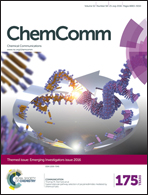Development of a disaggregation-induced emission probe for the detection of RecA inteins from Mycobacterium tuberculosis†
Abstract
A fluorescent sensor – InR – with disaggregation-induced emission (DIE) characteristics has been developed for the label free detection of RecA inteins from Mycobacterium tuberculosis. Mechanistic studies demonstrate that InR binds at a hydrophobic pocket of RecA inteins, which is constituted by Gly435, Glu434, Arg405 and Arg 7, resulting in the disaggregation and recovery of its fluorescence.

- This article is part of the themed collection: 2016 Emerging Investigators

 Please wait while we load your content...
Please wait while we load your content...